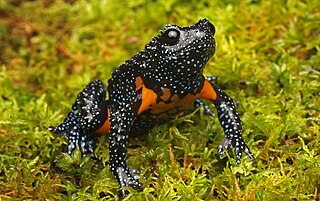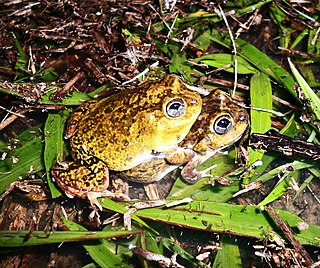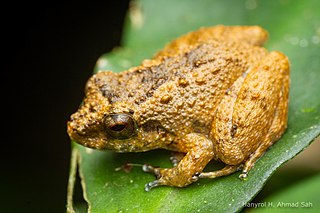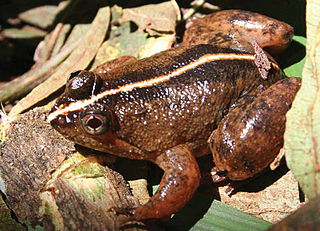
Pleurodema is a genus of leptodactylid frogs from South America. They are sometimes known under the common name four-eyed frogs, although this name can also refer to a particular species, Pleurodema bibroni. The common name is a reference to two inguinal poison glands that resemble eyes. When threatened, the frog lowers its head and raises its rear. When the frog adopts this posture, the poison glands are also raised toward the predator. The predator may also confuse the frog's raised posterior for the head of a larger animal.

Melanobatrachus is a genus of narrow-mouthed frogs in the family Microhylidae. It is the only remaining genus in the monotypic subfamily Melanobatrachinae. It contains a single species, Melanobatrachus indicus, also known as the Indian black microhylid frog and Malabar black narrow-mouthed frog. It is endemic to wet evergreen forests of southern Western Ghats in Kerala and Tamil Nadu states of India. It has been recorded from Anaimalai, Munnar, Palni hills, Periyar Tiger Reserve and Kalakkad Mundanthurai Tiger Reserve
Arthroleptis xenodactylus is a species of frog in the family Arthroleptidae. It is endemic to eastern Tanzania. Its natural habitats are lowland and montane forests where it occurs in leaf-litter, under logs, and in the axils of banana leaves. It is a locally common species that is threatened by habitat loss.
Nyctibates is a monotypic genus of frog in the family Arthroleptidae; its sole species is Nyctibates corrugatus. Found in Cameroon, Equatorial Guinea, and Nigeria, its natural habitats are lowland forests in hilly areas, typically forests that have humid, but not marshy, floors; it requires tall forests with closed canopy. Breeding takes place in fast, rocky streams with clean water. There are no significant threats to this species.
Celsiella revocata is a species of frog in the family Centrolenidae. It is endemic to the Venezuelan Coastal Range. Its common name, El Tovar glass frog, refers to its type locality, Colonia Tovar. Its natural habitats are montane forests along streams; it is usually found on vegetation above the streams.

Plectrohyla teuchestes is a species of frog in the family Hylidae. It is endemic to Guatemala and only known with certainty from its type locality on the southern slope of the Sierra de Xucaneb, in the Alta Verapaz Department. There is also a report from another locality in Alta Verapaz. Frogs from Honduras now known as Plectrohyla exquisita were formerly included in this species.

Leptopelis macrotis, sometimes called the big-eyed forest tree frog, is a species of frog in the family Arthroleptidae. It is found in the rainforests of Sierra Leone, southern Guinea, Liberia, Ivory Coast, and southern Ghana. Notice that similar common name "big-eyed tree frog" is sometimes used for Leptopelis vermiculatus from Tanzania and for Litoria exophthalmia from New Guinea.
Leptopelis modestus is a species of frog in the family Arthroleptidae. Its common names are modest forest treefrog and plain tree frog.
Pleurodema bibroni is a species of frog in the family Leptodactylidae. Its common name is four-eyed frog, although this name can also refer to the genus Pleurodema in general. The common name refers to two inguinal poison glands that resemble eyes. When threatened, the frog lowers its head and raises its rear. When the frog adopts this posture the poison glands are also raised toward the predator. The predator may also confuse the frog's raised posterior for the head of a larger animal.
Pleurodema borellii is a species of frog in the family Leptodactylidae. It is found in northwestern Argentina and southern Bolivia. The taxonomic status of this species is uncertain, and it may be a junior synonym of Pleurodema cinerea. It is abundant in Argentina, occurring in the Chaco-Yungas transition and montane grasslands on the eastern slopes of the Andes. Reproduction takes place in small permanent and temporary pools where pairs build floating foam nests. It is also found in disturbed habitats, including urban areas. No major threats to this species have been identified.

The Colombian four-eyed frog is a species of frog in the family Leptodactylidae. It is found in an area stretching from Guyana and northern Brazil through Venezuela and Colombia into Panama as well as the Netherlands Antilles.

Pleurodema bufoninum, the large four-eyed frog, is a species of frog in the family Leptodactylidae. It is found in Argentina and Chile. Its natural habitats are subantarctic forests, temperate forests, subantarctic shrubland, temperate shrubland, subtropical or tropical dry shrubland, subantarctic grassland, temperate grassland, intermittent rivers, swamps, intermittent freshwater marshes, arable land, rural gardens, ponds, and open excavations. The common name "four-eyed frog" refers to two inguinal poison glands that resemble eyes. When threatened, the frog lowers its head and raises its rear. When the frog adopts this posture, the poison glands are also raised toward the predator. The predator may also confuse the frog's raised posterior for the head of a larger animal.

Pleurodema diplolister, the Peters' four-eyed frog, is a species of frog in the family Leptodactylidae. It is endemic to Brazil. Its natural habitats are dry savanna, moist savanna, subtropical or tropical dry shrubland, subtropical or tropical dry lowland grassland, intermittent freshwater marshes, sandy shores, and pastureland. It is threatened by habitat loss. The common name "four-eyed frog" refers to two inguinal poison glands that resemble eyes. When threatened, the frog lowers its head and raises its rear. When the frog adopts this posture, the poison glands are also raised toward the predator. The predator may also confuse the frog's raised posterior for the head of a larger animal.
Pleurodema somuncurense is a species of frog in the family Leptodactylidae. It is endemic to the Somuncura Plateau in Patagonia, Argentina.

Alcalus baluensis is a species of frog in the family Ceratobatrachidae. It is endemic to northern and western Borneo. Its common name is Balu eastern frog or dwarf mountain frog. It was placed in the family Dicroglossidae before being transferred to Ceratobatrachidae in 2015.

Lankanectes corrugatus is a species of frog in the family Nyctibatrachidae. It was once monotypic within the genus Lankanectes, until the second species - Lankanectes pera was described in 2018 from Knuckles Mountain Range. It is endemic to Sri Lanka.

The common puddle frog, puddle frog, or yellow bellied puddle frog is a species of frog in the family Dicroglossidae. It has often been confused with Occidozyga sumatrana, and records of this species outside the Philippines likely represent that species.

Allopaa hazarensis is a species of frogs in the family Dicroglossidae. It is found in Hazara, Pakistan and in Kashmir in India and Pakistan. Its natural habitats are fast-flowing streams where it can occur both in torrential sections and in pools. Tadpoles use their oral disc as a sucker to hold on stones. Prolonged drought periods are a potential threat to this species.
Philautus aurantium is a species of frog in the family Rhacophoridae. It is endemic to Borneo and found in the Mount Kinabalu region in Sabah and Sarawak, Malaysia. Philautus gunungensis is sometimes considered its subspecies, Philautus aurantium gunungensis.

The Natal ghost frog is a species of frog in the family Heleophrynidae. It is the only species in the genus Hadromophryne.











